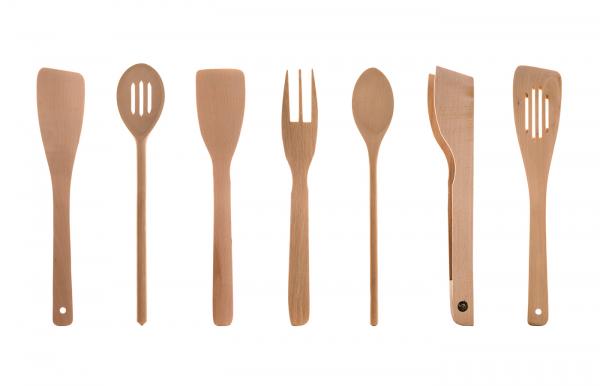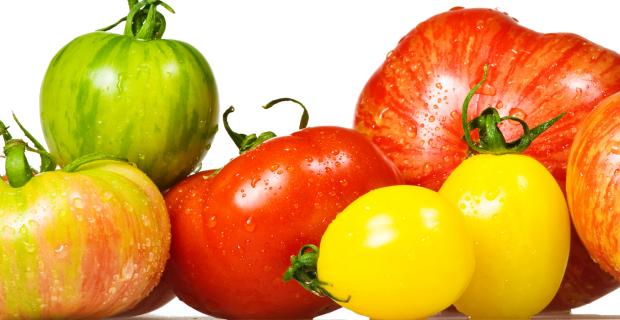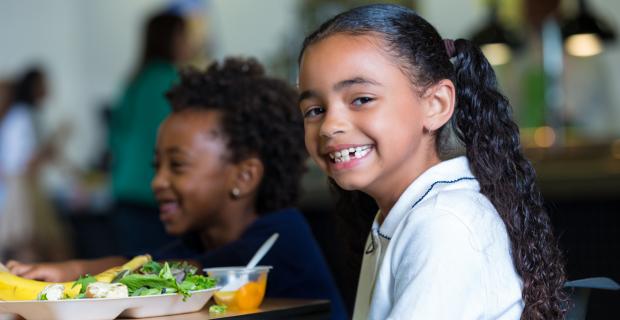Professional Development for Nutrition Services Staff

An Interview with Georgeanne Brennan
Since 2008, acclaimed cookbook author and teacher Georgeanne Brennan has offered professional development for food service staff members in Davis, California, in a collaboration between the Davis Joint Unified School District and the nonprofit Davis Farm to School.
Center for Ecoliteracy: With a shift to more fresh, local food in mind, what do you see as the goals of professional development for nutrition services staff?
Georgeanne Brennan: For me, professional development is more about exploration of food. One of Davis Farm to School’s most successful efforts at Davis has been a cooking school, which it has offered several times for the food service staff. When I began the classes, Raphaelita Curva (the director of Student Nutrition Services) and I agreed that we would just get in and make something, so that at the end of the two hours, there’d be finished things to taste and evaluate. I had done a book called Soups: Fast and Easy, and Curva and I agreed that we’d start with soups.
The shift to more fresh, local model implies cooking from scratch. Central kitchen staff members need to have professional development, but with the understanding that the training program is built on the skills that they have as people with lives of their own. It’s important to interest and empower them in ways that acknowledge their personal skills and lives. A lot of the women in our food service can chop circles around me. That’s part of their culture, what they grew up doing. It would be insulting to come in and say, “Here’s how you chop with a knife.”
CEL: Did you emphasize using local products?
GB: The Davis Joint Unified School District and Davis Farm to School have a Memorandum of Understanding, developed in 2007, that calls for 60 percent of the produce to be local, so the staff was already buying and using local product. I began helping them forage, or find product, from the Davis Farmers Market. We used that it in conjunction with some other product, which could be commodity dried beans or something else they had on hand. Then I added another element — we happened to take a butternut squash — and just gave them some ideas. I offered a selection of ingredients to try out different things. Each team of three or four created something without a recipe. And they just had a great time. There was all this bonding going on. I kept it easy, building on what they knew. This is the essence of adult education, or professional development, in the kitchen.
They loved tasting each other’s soups, realizing that cooking from scratch is different, because things vary. You know, you could have chard today that has a different flavor and texture than the chard of two weeks ago, depending on what Nature is doing. They got that every single thing you put in contributes to the flavor of what you’re doing. We did an olive oil tasting. They had been using pure olive oil, which has everything good gone from it. So we did a tasting, and right away, they completely understood the difference between pure and Extra Virgin California Olive Oil. The Davis school district now buys California Extra Virgin Olive Oil in bulk through a distributor, and that’s what they use.
A few little tips like that tend to really stick, and when they did their butternut squash, it was really fun to watch. Then, literally the next week, hot soup appeared on the school lunch menu for the first time ever. And now throughout the year, Student Nutrition Services offers hot soup, in elementary schools every Thursday and in secondary schools every day.
Another thing I did that was very effective was to bring in probably six salads from the deli of the Davis Food Co-op, which is a community partner with, and longtime supporter of, Davis Farm to School. The salads could have been from anywhere, nice salads high in flavor, including some vegetarian, for them to taste. The salads had their ingredient labels on them. One of the salads that everybody loved was kale and beet. So they saved the label and concocted their own version of this salad, and that was on the salad bars for a whole month. The Davis central kitchen staff is highly creative.
CEL: How can that approach be expanded?
GB: My business partner Ann Evans and I, through Evans & Brennan, are developing and presenting, in collaboration with the Center for Ecoliteracy, a “6-5-4 Seasonal Flavors Matrix” that combines six dishes kids know and love (pizza, pasta, soup, salads, wraps, and rice bowls), with five flavor profiles that reflect the diverse population of California and the nation (Asian, Indian/Middle Eastern, Latin, Mediterranean/European, and African), and fresh ingredients according to the four seasons. We begin with Student Nutrition Services staff members’ learning to prep some basic dishes and create variations. Maybe they do a chicken and rice dish with sugar snap peas in the spring, and then it’s chicken and rice with red peppers in the fall, and in the winter, it might be broccoli. We help them build a foundation — not “Here are some random recipes,” but “Here’s a way, a framework, to think about what you’re cooking.”
CEL: It sounds like what you’re doing has a lot to do with inviting them to be creative.
GB: This is something we’ve been working on, making the entrée item a little bit different while incorporating fresh local fruits and vegetables into it. For example, they do a pasta dish with canned tomatoes, and then they use some different herbs, according to what’s available, and add chopped kale or chard. Note also that we help them build a freshly prepared or scratch-cooking entrée based on the USDA commodity products, like pasta and canned tomatoes, which helps to keep their cost down yet produces a high-flavor, in-season dish.
They have become very creative about doing this. There is a sweet and sour chicken that they chop sugar snap peas into. That was their idea. I didn’t teach them that. I’ve been able to see over the last two and a half years the evidence that they have internalized many of these concepts.
In Davis, there are a couple of Pakistani women, recent immigrants, and also several from Mexico. We did a chicken mole. One woman said, “Well, that’s okay, but that’s not how we make it.” I said, “Fine, make it how you make it.” She just set to work. So we had three different mole sauces.”
If you allow the expertise that is already in your kitchen staff to come to the foreground, you’re not only empowering them, but you’re enriching the rest of the staff. You want to come in on a peer level.
CEL: What else have you learned from offering professional development this way?
GB: Do it with real meals. I know there are programs that say, “Here are some snacks where you can dip carrots in dill dressing.” To me, that’s not as valuable as providing a framework to create systemic change in the food being offered on the school lunch tray.
Hands-on is transformative. I limit class sizes to about fifteen, because if you have fifty, then nobody’s really doing anything — they are passive rather than active. With a small, hands-on class, they become teachers in their own environment.
I think there’s a fine line between guidance and control. So I can see, for example, if I said, on seeing someone chopping carrots for a dish, “Oh, no, this is for carrots julienne. Don’t chop them.” It would be critical. Instead, I’ll say “Oh, good idea. They can be chopped or julienned, like this” and then demonstrate. These are adults who have families and all the complications and joys of any adult life, and I think that as a teacher, as a resource person, it’s really important to acknowledge that and allow for variations, for the ebb and flow of life. It’s not going to make a difference in the end if the carrot is julienned or chopped.
Another aspect is not starting with, “We’re going to cook for fifty people.” Start with family-sized batches, which makes it more like recipe testing. Then if it really works, they can scale it up and run the nutrition analysis as necessary and do whatever it takes to feed everybody.
After you’ve cooked whatever it is in the cooking class session, it’s absolutely key to bring the group together to present and explain to the group what they’ve made. That’s partly about empowerment, building self-esteem and pride. I’ve found increasingly that these presentations are very important to them. They’ve begun using nice serving platters and serving bowls, and garnishing things with herbs from their own garden, of which they’re very proud. They’ve also found their public voice. Nutrition Services Director Raphaelita Curva asks them, after each presentation, what grade levels they think the recipe would be suitable for, and what changes, if any, would be necessary to introduce it. The staff members work together to make the decisions on what to introduce into the menu, and when and how.
CEL: You’ve emphasized the importance of building self-esteem a couple of times. What role can professional development play in that?
GB: You build the sense of being a professional, of being part of a valued group.
For instance, the Davis Farm to School organization invited the director of Student Nutrition Services to bring her staff to join chefs from leading local restaurants on a “Chefs’ Walk” that Evans & Brennan had organized to promote farmers market products in restaurants throughout the region. Being treated as peers of professional chefs was very successful. The director made sure they all had “chef’s whites” to walk through the market, which added to the excitement and professionalism of the day. Davis Farm to School, through a grant from the USDA, paid for staff time.
You can also bring in local cooks and restaurants and institutions of higher learning as part of professional development. Another way to enhance professional development is to include nutrition services staff whenever there’s one of those walk-around fundraising tasting events like Rotary or other community groups put on. You can work with the local Chamber of Commerce so that the community begins to see student nutrition services in a larger role with culinary peers and begins to change that notion of them as just the absolute lunch ladies, bottom of the pit.
It’s partly self-image, and it’s also the way they’re treated. There’s hospitality training that needs to be done at all levels that elevates the nutrition services staff. You know, I mean just common courtesy would help. But sometimes if you work from the outside in — for example, if these principals and so forth see their kitchen staff at the farmers’ market in chefs’ coats with other chefs — they have a different notion of them. Sometimes, the student nutrition services staff are doing all they possibly can, and they need the support from other adults in the lunchroom to transform the dining environment, model the behavior by eating the school lunch, and engage the kids in some discussion about the food.
CEL: Is learning how to introduce food to kids part of professional development?
GB: The staff doesn’t want to make food that no one eats. That’s depressing. There’s been a request from the Student Nutrition Services staff, “We want to be able to tell these kids how good this is. We know that carrots are good for you, but we want to have a few things like nutrition facts that we can say.”
The key to the kids’ eating it is to have a sampling program. If the kids sample it while they’re waiting in line, they will choose that item. There are many ways to do things. In the Davis schools, Curva works with Davis Farm to School to run a sampling program. Volunteers solicited by Talia Hack Davies, program director for Davis Farm to School, hand out samples in the lunch line, and then the sampler goes out into the lunchroom or lunch yard and offers samples to the kids who brought their lunch. Sometimes staff members assist with this if they are able. Students begin to change from the notion that school lunch is yucky to the idea that school lunch is good. How you present the food matters too, carrying over the atmosphere we’re encouraging in the cooking class, with the nice platters and bowls.
CEL: Do you incorporate procurement into professional development?
GB: The way I approach professional development around procurement is, the more information that can be provided, so that people are making informed decisions, the better. That’s really the best that you can do.
You’re not going to make forty-two phone calls to different farmers, so it’s helpful to work with distributors who can provide procurement invoices that indicate the provenance. It teaches the staff, particularly whoever is doing the buying, when they order grapes in December, “These grapes are coming from Chile,” whereas without that, they may think, “Grapes are good; grapes are healthy; kids like grapes.” If they want to buy them from Chile, that’s their decision, but at least they do it with knowledge about where the grapes come from. I’ve been working with Jim Mills of Produce Express in Sacramento, who has perfected provenance on the invoices he provides to Davis Student Nutrition Services.
CEL: What other kinds of administrative support do you need to do effective professional development?
GB: One thing that’s important to take a look at as they move to fresh and local food is that they need not just a different set of skills — they may already have those skills — but they need to have some decent equipment. You cannot ask people to work with fresh fruits and vegetables when they have crummy knives or a limited number of knives, which was the case in Davis. They were trying to do fresh barbecues for the kids. They only had two spatulas. This is where outside support can come in.
There is a company, Meyer Corporation, which is the largest kitchen cookware and cutlery distributor in the United States. I’ve worked with them, and they’ve been very generous in donating equipment that schools need. Within your local community, it may be your local hardware store. You really need to ensure that the people trying to produce this food have appropriate equipment. A school lunch booster club like Davis Farm to School can also buy equipment for the central kitchen or satellite kitchens.
And kids need utensils that fit the meals, actual knives, forks, and spoons. We work with the kitchen staff to learn to prepare actual pieces of chicken instead of sending their commodity chicken off to be turned into alphabet chicken, but you can’t eat the chicken pieces with a spork. I’ve tried; it’s impossible. And sporks are wrapped with a napkin in cellophane and create more waste, which itself costs money to pick up and haul away. Better food goes hand in hand with waste reduction.
CEL: Where would you find people to lead this kind of professional development?
GB: I think cookbook authors are a good place to look. There’s a nationwide group called Les Dames d’Escoffier, with women who are professionals in food and well connected to the farmers’ market movement. Any chefs who are active in Slow Food or Chefs Collaborative, because there’s an inclusive political ethos there. Perhaps interested local restaurateurs as well.
In collaboration with the Center for Ecoliteracy and the TomKat Charitable Trust, we are producing a cookbook and manual to teach the 6-5-4 approach and are also planning cooking schools and conferences to showcase this professional development strategy.
Teachers or students from culinary institutes seem like obvious sources, but what they’re teaching there is very different from school food service, where the goal is to feed thousands of kids every day in a limited amount of time on a very tight budget.
CEL: We sometimes hear that food service staff members are resistant to new programs, because they’re being asked to do something different.
GB: I’ve found that they’re receptive when you’re offering something that they want. And it should be fun. I love to go, and they seem to love to have me. It is important to respect what they already know, to acknowledge they have adult lives and families. Raphaelita Curva, the director of Student Nutrition Services, says it’s been one of the best things that have happened in terms of morale and recipes and food. She invited the professional development to begin with, knowing her staff would enjoy and benefit from it. She pays for half the cost of the time for the staff, and the booster club, Davis Farm to School, pays for the other half and for my time as instructor. Davis Farm to School has also introduced waste reduction practices into the central kitchen, which Curva and her staff have embraced. When you bring in more fresh food, you have more of a different kind of waste. They’ve been great about wanting to compost and recycle.




